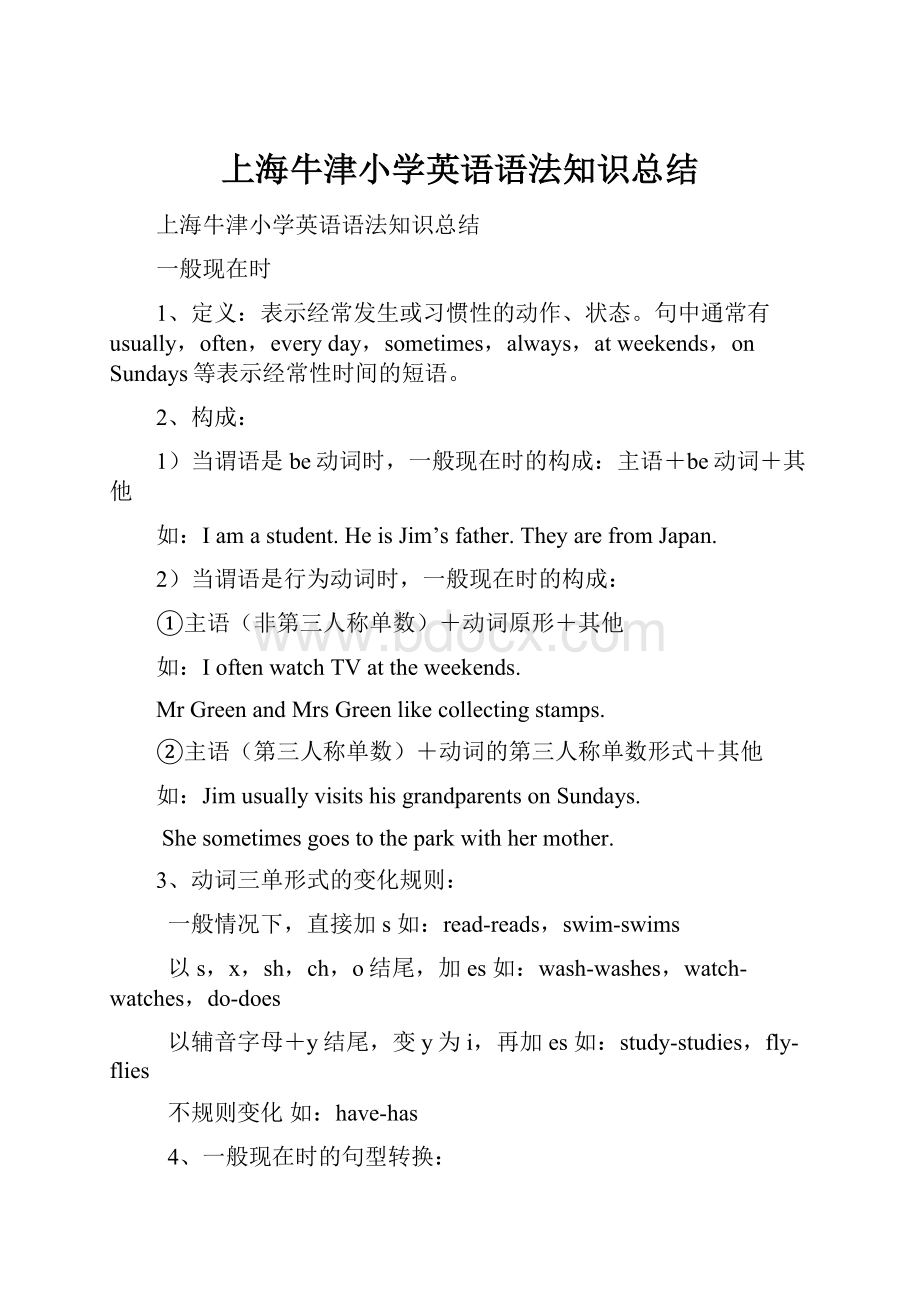上海牛津小学英语语法知识总结.docx
《上海牛津小学英语语法知识总结.docx》由会员分享,可在线阅读,更多相关《上海牛津小学英语语法知识总结.docx(8页珍藏版)》请在冰豆网上搜索。

上海牛津小学英语语法知识总结
上海牛津小学英语语法知识总结
一般现在时
1、定义:
表示经常发生或习惯性的动作、状态。
句中通常有usually,often,everyday,sometimes,always,atweekends,onSundays等表示经常性时间的短语。
2、构成:
1)当谓语是be动词时,一般现在时的构成:
主语+be动词+其他
如:
Iamastudent.HeisJim’sfather.TheyarefromJapan.
2)当谓语是行为动词时,一般现在时的构成:
①主语(非第三人称单数)+动词原形+其他
如:
IoftenwatchTVattheweekends.
MrGreenandMrsGreenlikecollectingstamps.
②主语(第三人称单数)+动词的第三人称单数形式+其他
如:
JimusuallyvisitshisgrandparentsonSundays.
Shesometimesgoestotheparkwithhermother.
3、动词三单形式的变化规则:
一般情况下,直接加s如:
read-reads,swim-swims
以s,x,sh,ch,o结尾,加es如:
wash-washes,watch-watches,do-does
以辅音字母+y结尾,变y为i,再加es如:
study-studies,fly-flies
不规则变化如:
have-has
4、一般现在时的句型转换:
肯定句
否定句
一般疑问句及回答
TheywatchTV
everyday.
Theydon’twatchTV
everyday.
—DotheywatchTVeveryday
—Yes,theydo./No,theydon’t.
ShewatchesTV
everyday.
Shedoesn’twatch
TVeveryday.
—DoesshewatchTVeveryday
—Yes,shedoes./No,shedoesn’t.
现在进行时
1、定义:
表示现在或现阶段正在进行或发生的动作。
句中常有now,look,listen等词。
如:
Iamwashingclothesnow.
Look!
LiuTaoisclimbingthetree.
Listen!
Janeissinginginthemusicroom.
2、构成:
be动词(am/is/are)+动词现在分词(V-ing)
3、动词现在分词构成:
一般是在动词原形后加ing
如:
read-reading,drink-drinking,eat-eating,look-looking
以不发音的e结尾的动词,去掉e,再加ing
如:
write-writing,make-making,ride-riding,take-taking
以重读闭音节结尾,如末尾只有一个辅音字母,要双写这个字母,再加ing
如:
sit-sitting,swim-swimming,put-putting,run-running,stop-stopping,get-getting,begin-beginning,jog-jogging,forget-forgetting
4、动名词其实就是动词的现在分词,它既有名词性质(可作主语),又有动词性质(可带宾语)。
如:
Askingtheway
Myhobbyiscollectingstamps.
Heisgoodatskating.
5、现在进行时的句型转换:
肯定句
否定句
一般疑问句及回答
Heisrunningnow.
Heisn’trunningnow.
—Isherunningnow
—Yes,heis./No,heisn’t.
Theyaremaking
apuppet.
Theyaren’tmaking
apuppet.
—Aretheymakingapuppet
—Yes,theyare./No,theyaren’t.
一般过去时
1、定义:
表示过去某个时间里发生的动作或存在的状态。
常和表示过去的时间状语连用,如:
amomentago,justnow,yesterday,lastweek,thismorning等。
如:
Mybrotheroftenwenttoschoolbybikelastterm.
Thewatchwasbesidethediaryamomentago.
IwatchedthemoonandatethemooncakeslastMid-AutumnFestival.
Jimwenttothesupermarketyesterday.
2、构成:
主语+动词的过去式+其他
3、动词过去式的变化规则:
一般在动词原形末尾加ed如:
play-played,listen-listened,look-looked
结尾是e的动词,加d如:
live-lived,like-liked,taste-tasted
辅音字母+y结尾的动词,变y为i,再加ed如:
study-studied,carry-carried,cry-cried
末尾只有一个辅音字母的重读闭音节词,双写这个辅音字母,再加ed如:
stop-stopped,plan-planned
不规则变化如:
am/is-wasare-werehave/has-haddo-did
go-wentsit-sattell-toldsee-saw
get-gotmake-madegive-gaveread-read
buy-boughtcome-camedraw-dreweat-ate
fly-flewmeet-metput-putrun-ran
say-saidsing-sangswim-swamtake-took
4、一般过去时的句型转换
肯定句
否定句
一般疑问句及回答
HewatchedTVyesterday.
Hedidn’twatchTVyesterday.
—DidhewatchTVyesterday
—Yes,hedid./No,hedidn’t.
Theyplayedgamesjustnow.
Theydidn’tplaygamesjustnow.
—Didtheyplaygamesjustnow
—Yes,theydid./No,theydidn’t.
一般将来时
1、定义:
表示将要发生的动作或存在的状态,以及打算、计划或准备某事。
句中一般含有表示将来的时间状语,如:
tomorrowmorning,nextweek,thisafternoon等表示将来的时间状语。
2、构成:
①begongto+动词原形
如:
IamgoingtoseeaBeijingoperatomorrow.
Wearegoingtomeetatbusstopathalfpastten.
DadandIaregoingtoseeaBeijingoperathisafternoon.
②will+动词原形
如:
Theywillgoswimmingthisafternoon.
3、begoingto和will区别:
①begoingto表示经过事先安排、打算或决定要做的事情,基本上一定会发生;will则表示有可能去做,但不一定发生,也常表示说话人的临时决定。
如:
Iamgoingtotakepartinapartythisevening.
Theyarecleaningthelibrarynow.I’llgoandjointhem.
②begoingto表示近期或眼下就要发生的事情;will表示的将来时间则较远一些。
如:
Heisgoingtowritealettertomorrow.Iwillmeetheroneday.
③begoingto还可以用来表示有迹象表明某件事将要发生,常用于天气等自然现象。
如:
Look!
It’sgoingtorain.
4、一般将来时句型转换:
肯定句
否定句
一般疑问句及回答
Sheisgoingtohaveapicnictomorrow.
Sheisn’tgoingtohaveapicnictomorrow.
—Isshegoingtohaveapicnictomorrow
—Yes,sheis./No,sheisn’t.
Theywillgoswimmingthisafternoon.
Theywillnot(won’t)goswimmingthisafternoon.
—Willtheygoswimmingthisafternoon
—Yes,theywill./No,theywon’t.
句法
1、陈述句
说明事实或陈述说话人观点的句子。
基本结构:
主语+谓语+其他
1)肯定陈述句Wealllikepandasverymuch.
2)否定陈述句Hedoesn’tdohouseworkatweekends
3)肯定陈述句改否定陈述句
①一般是在be动词或情态动词后加not。
Marywasatschoolyesterday.—>Marywasnotatschoolyesterday.
Icanmakeamodelplane.—>Icannotmakeamodelplane.
②不含be动词或情态动词的,行为动词前要用助动词的否定式(don’t,doesn’t,didn’t),后面跟动词的原形。
Helikesdrawingpictures.—>Hedoesn’tlikedrawingpictures.
Iwenttotheparkyesterday.—>Ididn’tgototheparkyesterday.
4)陈述句改一般疑问句
①有be动词或情态动词的,把be动词或情态动词提前。
Marywasatschoolyesterday.—>WasMaryatschoolyesterday
Icanmakeamodelplane.—>Canyoumakeamodelplane
②不含be动词或情态动词的句子,借助助动词开头,动词还原成原形。
Helikesdrawingpictures.—>Doeshelikedrawingpictures.
Iwenttotheparkyesterday.—>Didyougototheparkyesterday
2、疑问句
用来提出问题,询问情况的句子,末尾用问号。
1)一般疑问句:
一般疑问句常用来询问一件事是否属实,通常以be动词,助动词或情态动词开头,用yes或no来回答,因此又叫是非疑问句,通常读升调。
—IsMrGreenfromtheUK—Yes,heis./No,heisn’t.
—Doyouhaveanyhobbies—Yes,Ido./No,Idon’t.
—Canyouplaytheguitar—Yes,Ican./No,Ican’t.
2)特殊疑问句:
以特殊疑问词引导,要求回答具体问题,不能用yes或no来回答。
—Howdoyougotoworkeveryday—Igotoworkbycar.
3)选择疑问句:
提供两种或两种以上情况,让对方选择,往往用or连接。
—Wouldyoulikesometeaorcoffee—Somecoffee,please.
4)反意疑问句:
反意疑问句是由陈述句和附在其后的附加疑问句组成。
—It’safineday,isn’tit—Yes,itis.
3、祈使句
表示请求或命令别人做某事或不做某事。
1)用于第二人称,通常省略you。
①肯定祈使句:
Openthedoor,please.
②否定祈使句:
Don’tbelateagain.
2)用于第一人称和第三人称,通常以let(let后跟宾格)或shall开头。
Letmehavealook.Let’splayagamenow.Lethimgohomenow.
ShallwemeetatonethirtyinfrontoftheGardenTheatre
4、感叹句
表达喜怒哀乐等强烈感情,句尾常用感叹号(!
),语气用降调。
1)what+名词或名词性短语
Whatabiggarden(itis)!
Whataninterestingstorybook(itis)!
Whatlovelyweather(itis)!
Whatprettygirls(theyare)!
2)how+形容词或副词+主语+动词
Hownice!
Howbeautifultheflowersare!
HowtallYaoMingis!
5、therebe句型表示在某地有某人或某物。
1)主语是单数,be动词用is(was);主语是复数,be动词用are(were)。
Thereissomemilkinthefridge.
Therearesomepeachesinthebasket.
2)如果有几个不同的人或物并列存在,be动词根据最靠近的那个名词而定。
Thereisarulerandfiveknivesinthepencilcase.
Therearefiveknivesandarulerinthepencilcase.
3)therebe句型和have/has区别:
therebe句型表示某地有某人或某物;
have/has表示某人有某物。
has用于第三人称单数,其余人称和数用have。
TherearesomeEnglishbooksonthedesk.
IhavesomeEnglishbooks.
精心搜集整理,请按实际需求再行修改编辑,因文档各种差异排版需调整字体属性及大小